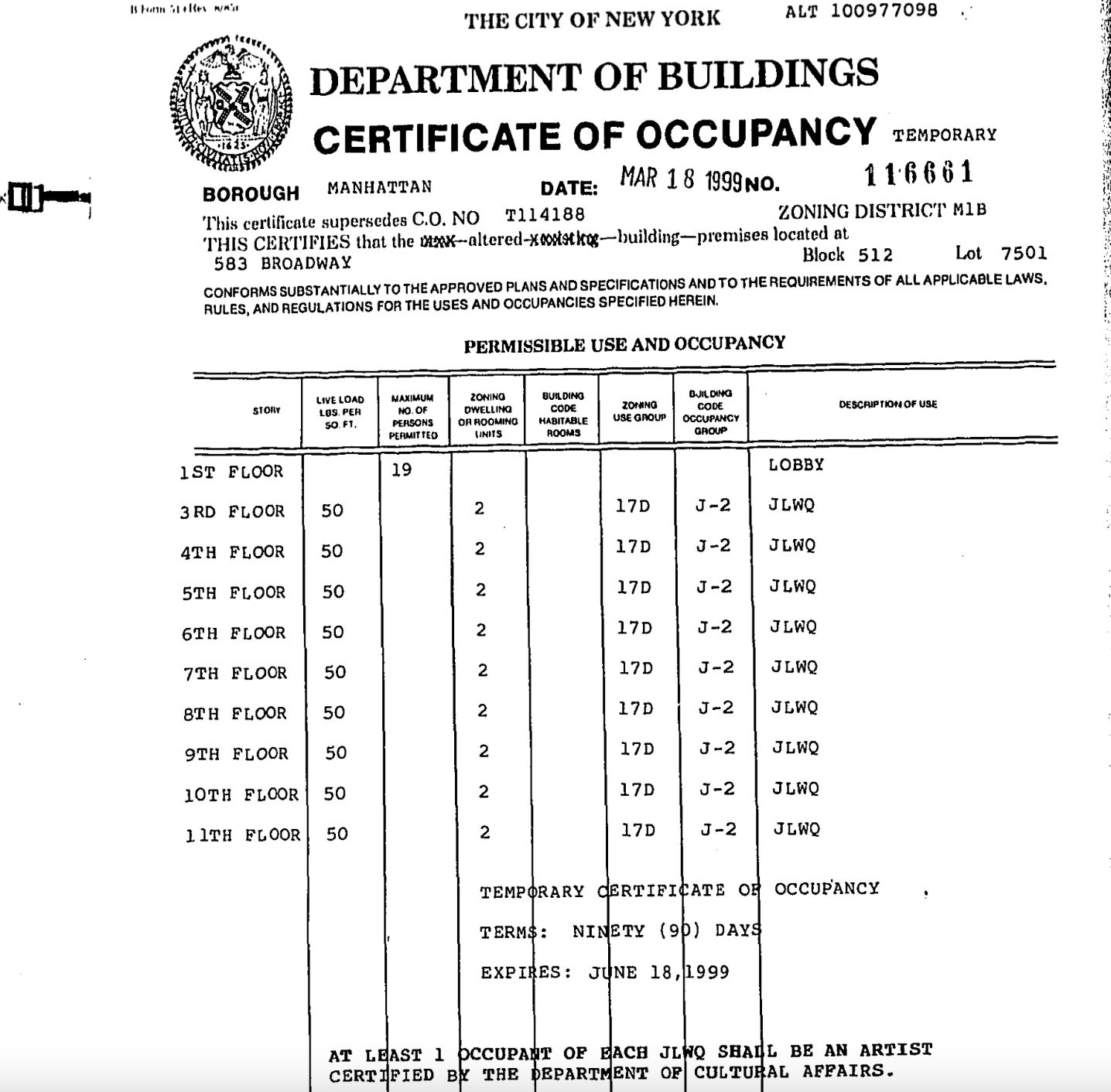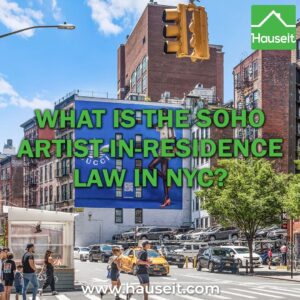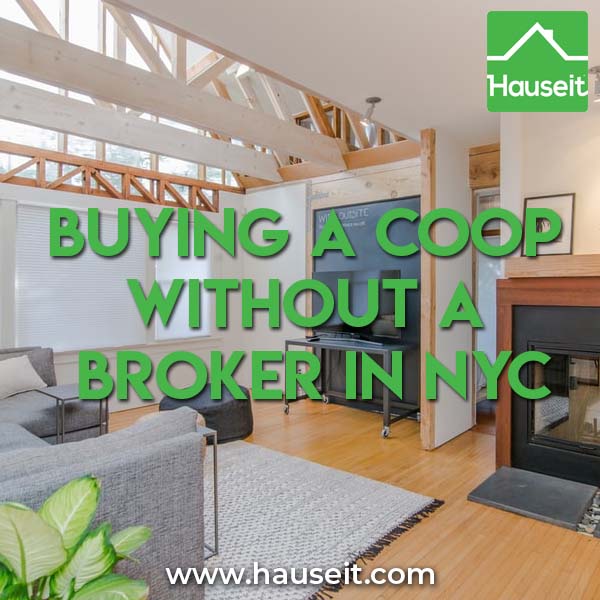The SoHo Artist-in-Residence (A.I.R.) Law was enacted in 1971 to allow artists to legally live in former commercial buildings in SoHo and NoHo which were zoned for manufacturing. At the time, these neighborhoods were a haven for artists, but existing zoning laws did not permit former industrial buildings in SoHo and NoHo to legally be used as residential loft spaces.
The Artist-in Residence Law allowed artists to legally reside in former commercial buildings as live/work spaces, on the condition that each qualifying unit had at least one occupant who was ‘certified artist.’
This required artists to submit an application to the NYC Department of Cultural Affairs in order to obtain an official “Artist Certification.”
The Artist Certification legally equates the named artist to a light manufacturer, thus qualifying for occupancy in buildings zoned for manufacturing. Lofts which are part of the Artist-in-Residence program are often referred to as “Joint Live Work quarters for Artists” or JLWQA.
While SoHo and NoHo have continued to gentrify into some of the wealthiest enclaves in the city, the Artist-in-Residence law is technically still in effect. The Department of City Planning estimates that there are currently 1,636 lofts designated as JLWQA.
However, the recent rezoning of SoHo and NoHo in 2021 obviated the need for JLWQA since it converted former manufacturing districts into mixed-use districts which permit residential use. The rezoning process created a framework for converting existing JLWQA units into unrestricted residential units, albeit with a huge flip tax of $100-per-square-foot.
Recent legislation has also been passed which establishes the rights of occupants of JLWQA units who were in residence prior to December 15, 2021 to continue living in these units legally regardless of their status as a certified artist.
Click on the sections below to learn more. Thinking of buying in NYC? Estimate your buyer closing costs in NYC using Hauseit’s Buyer Closing Cost Calculator, and consider requesting a Hauseit Buyer Closing Credit to save money on your purchase.
Table of Contents:
How does the SoHo Artist-in Residence law work?
Who qualifies as a certified artist?
What are JLWQA Joint Live Work Quarters for Artists?
Can a non-artist purchase a loft in SoHo or NoHo?
What are the risks of violating the SoHo Artist-in-Residence law?
How will rezoning affect the SoHo Artist-in-Residence law?
How does the SoHo Artist-in Residence law work?
The Artist-in-Residence law of 1971 created a special zoning use classification called Joint Living Work Quarters for Artists (JLWQA) in the manufacturing districts of SoHo and NoHo (M1-5A and M1-5B). At the time, these zoning districts prohibited residential use.
Artists who were certified by the NYC Department of Cultural Affairs (DCLA) were designated as light manufacturers and were therefore allowed to live in these neighborhoods despite the fact that the zoning code did not allow for residential use.
Who qualifies as a certified artist?
The NYC Department of Cultural Affairs is designated as the certifying agency for the SoHo Artist-in-Residence law.
The NYC Department of Cultural Affairs defines an “artist” as “a person who is regularly engaged in the fine arts, such as painting and sculpture, or in the performing or creative arts, including choreography and filmmaking, or in the composition of music, on a professional basis and is so certified by the city department of cultural affairs and/or state council on the arts.”
The following persons do not qualify for an Artist Certification according to the department:
-
Students and others who do not yet have a professional body of work covering five years prior to their application
-
Commercial artists, hobbyists, and others for whom fine arts are not a primary vocation
According to the agency’s official guidelines, applications for certification by this Department are reviewed by an advisory committee (Artist Certification Committee) of professional artists, art educators, and administrators representing a variety of fine arts disciplines, who then make a recommendation to the Commissioner of Cultural Affairs.
Applications are required to meet the following criteria outlined by the department:
-
Regularly engaged. The individual is currently engaged in and demonstrates a serious, consistent commitment to his or her art form or art occupation;
-
Fine arts. The individual is engaged in an art form or art occupation that can be considered and is pursued by the individual as a “fine art”, evidenced by a substantial element of independent esthetic judgment and self-directed work. The production of work solely on a commercial, industrial or work-for hire basis without evidence of the foregoing elements is not sufficient to demonstrate pursuit as a “fine art”;
-
Professional basis. The individual is committed to the art form or art occupation as his/her primary vocation and others in the field recognize the individual as a professional with regard to the art form or occupation; and
-
Intent to use joint living-work quarters. The individual demonstrates the intent to use joint living work quarters for the purpose of carrying out his/her art form or art form or occupation.
If granted, an artist’s certification is valid for as long as the applicant resides in the loft which she or he lived in at the time of certification. An artist’s certification may not be transferred to another individual.
A Full Service Listing for 1%
Sell your home with a traditional full service listing for just one percent commission.
What are JLWQA Joint Live Work Quarters for Artists?
JLWQA (Joint Live-Work Quarters for Artists) is the official designation given to units which qualify under the SoHo Artist-in-Residence law.
Here is a sample Certificate of Occupancy for a building in SoHo which references the JLWQA (Artist-in-residence) designation:

Can a non-artist purchase a loft in SoHo or NoHo?
Yes, a non-artist can legally purchase a JLWQA (Artist) loft in SoHo or NoHo if it is converted to residential use under the procedure outlined as part of the adoption of Special SoHo-NoHo Mixed Use District (SNX) in December 2021.
The conversion process involves making a $100 per square foot contribution to the SoHo/NoHo Arts Fund and submitting applications to the Department of City Planning and the NYC Department of Buildings.
Prior to the 2021 SoHo/NoHo rezoning, it was not unheard of for non-artists to purchase JLWQA lofts. However, this carried risks for purchasers. The seller of a JLWQA unit would typically seek to indemnify her or himself by asking the buyer to sign an acknowledgement of the need for at least one occupant to be a certified artist.
Now that conversion framework exists for JLWQA units, a seller will likely be expected to convert the unit prior to resale.
What are the risks of violating the SoHo Artist-in-Residence law?
Historically, there were several risks to violating the SoHo Artist-in-Residence law. Non-artist residents of JLWQA (Artist lofts) in SoHo and NoHo were subject to fines of up to $1,250.
Moreover, if a Department of Building (DOB) inspector discovered that a unit did not have at least one certified artist occupant, a violation could be issued for the entire building. However, there was very little anecdotal evidence that these laws were enforced over the years.
Fortunately, legislation was passed in 2022 which provides blanket protection to all loft residents whose occupancy began on or before 12/15/21 regardless of their status as a certified artist. Senate Bill S8793 was signed into law by Governor Hochul on July 21, 2022.
The impetus behind this legislation is summarized in the bill’s press release:
Nevertheless, be especially careful if you aren’t a certified artist and the building you’re buying into doesn’t have a permanent Certificate of Occupancy. This is because the NYC Department of Buildings may ask to see the artist certificates for residents in the building before agreeing to renew a Temporary Certificate of Occupancy (TCO).
If your building’s TCO isn’t renewed, it may be difficult or impossible to buy insurance, secure financing or sell the property.
It’s also possible that the condo or co-op building itself could order an individual unit to obtain a certified artist designation.
The rezoning plan did not alter the rules for existing Joint Living Work Quarters for Artists (JLWQA) under the Artist-in-Residence law.
However, the rezoning plan created a framework for voluntary conversion from JLWQA status to unrestricted residential use.
Applications to convert JLWQA to unrestricted residential use require administrative approval by the Chairperson of the City Planning Commission (“CPC Chairperson Certification”) at the Department of City Planning. The requirements are as follows:
-
A one-time contribution to the SoHo/NoHo Arts Fund. (For the 2021 fiscal year, the contribution rate is $100 per square foot of converted floor area. The rate will be adjusted annually with inflation per the Consumer Price Index.)
-
Execution and recordation of a Notice of Certification against the zoning lot. (Applicants will be provided with a template during the application process.)







